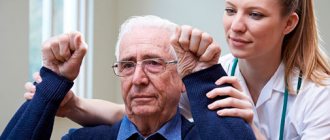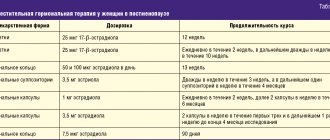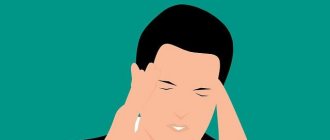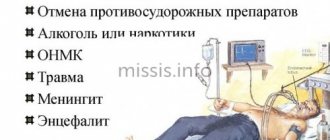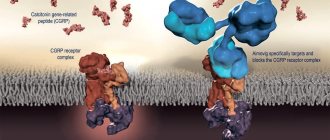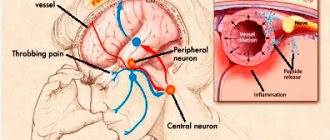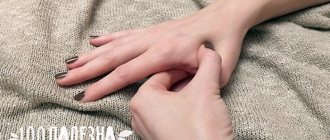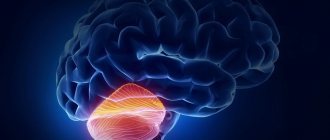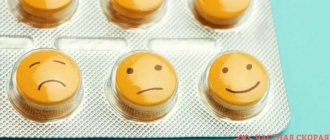Neurologist (algologist)
Vasilenko
Marina Gennadievna
25 years of experience
Head of the Pain Treatment Center, neurologist-algologist, member of the Society of Neurologists and Neurosurgeons, Russian Society for the Study of Pain, Association of Interdisciplinary Medicine, International Association for the Study of Pain (IASP)
Make an appointment
Migraine has been known to mankind for many centuries. This disease is characterized by severe paroxysmal headaches. Experts define migraine as a type of neurological pathology, which is characterized by pain localized in one half of the head. The nature of the pain and the absence of organic causes causing it significantly complicate the diagnosis of the disease. Migraine, the symptoms and treatment of which depend on many factors, is classified by doctors as a chronic disease that is practically untreatable. At the same time, provided that certain preventive measures and rules are followed, attacks can be successfully stopped and their number reduced. Questions regarding how to treat migraines are found quite often on the Internet. The best way to solve this problem is to timely contact a qualified doctor who will conduct a comprehensive examination and suggest a course of treatment.
Symptoms and signs of migraine
In most cases, migraine manifests itself, the symptoms of which depend on the cause of the pathology, severe throbbing pain in the head. In addition to severe pain with throbbing, hemicrania is characterized by:
- nausea or vomiting, loss of appetite and often slight weight loss;
- dizziness;
- irritability up to attacks of aggression;
- drowsiness;
- increased sensitivity to smells, tastes and light.
Symptoms depend on the stage of development of the pathology. After the migraine attack passes, patients usually feel well. Experts identify the following stages of disease development:
- precursors of migraine are characterized by manifestations of depression, fatigue, and irritability several hours before the attack. Some patients, on the contrary, feel an increase in activity and appetite;
- aura, which is a reflection of certain processes occurring in the brain that are associated with the mechanism of migraine development. The duration of the aura is on average up to 30 minutes, but in some cases the stage can be longer. This stage is characterized by visual effects such as blind spots, flashes of light, sensory effects such as numbness or tingling sensations, problems finding words or difficulty speaking. Symptoms may appear individually or in combination;
- The headache can last from 2-3 hours to several days. Very strong pain of a bursting or pulsating nature can cover the entire head or be localized in the temporal region. At this stage, nausea or vomiting attacks and a desire to hide in a dark room alone are common;
- resolution follows the headache phase and is accompanied by fatigue, depression, or irritability. Concentration is difficult. Symptoms persist for up to a day.
Medical myths. Migraine and eleven misconceptions
Migraine is a fairly common disease. In the United States alone, more than 37 million people suffer from persistent or episodic migraines, with global estimates reaching 148 million. Data are published indicating a steady, year after year, trend towards an increase in the prevalence of migraine headaches.
According to the World Health Organization (WHO), migraines are approximately twice as common in women as in men.
The main symptom of migraine is headache, ranging in intensity from moderate to severe; 85% of patients describe this pain as throbbing. It is generally accepted that the word “migraine” by default implies a headache on one side or in one area, but only about 60% of patients complain of a clearly unilateral localization. 80% experience nausea, 30% vomit. In addition, the vast majority note painful sensitivity to bright light (90%) and loud sounds (80%).
Below we will try to examine in detail eleven myths that have developed around the problem of migraine headaches. Let's try not to forget about medications, caffeine, nutrition and much more. We turned to three experts for help and clarification:
— Dr. Vernon Williams, board-certified neurologist specializing in sports medicine and director of the Center for Sports Neurology and Pain Medicine at the Cedars-Sinai Kerlan-Jobe Institute in Los Angeles, California;
— Dr. Medhat Michael, a pain management and pain management specialist and medical director of the non-operative program at the Spinal Health Center at Memorial Care Orange Coast Medical Center in Fountain Valley, California;
— Dr. Jennifer McVidge, board certified in pediatric neurology and neuroimaging, director of the Traumatic Brain Injury Center at DENT Neurological Institute, Amherst, New York.
Migraines are nothing
“Most migraine variants are not serious. However, this disorder can be chronic, sometimes literally debilitating, and in the absence of adequate treatment, some cases result in disability,” explains Dr. M. Michael.
The authors of a review published in the journal Neurology on the impact of migraine on quality of life noted that many people with migraine “... report reduced performance and various disturbances in family life, social functioning and leisure activities.”
It must be emphasized that migraine occurs in various forms and types, and they manifest themselves differently. For example, “there is a variant called hemiplegic migraine, which tends to be a familial, inherited disorder. This type is associated with significant neurological symptoms, a peculiar preceding “aura” before a migraine attack, as well as an increased risk of stroke,” says Dr. M. Michael.
However, the expert, in order not to cause a surge of unfounded anxiety in this regard, hastens to clarify: “Hemiplegic migraine, which can cause muscle weakness or paralysis on one side of the body, is rare and affects only about 0.01% of the population (according to PubMed Central, a database of the National Institutes US health care - Note Lakhta Clinic ). In most cases, paralysis resolves within a few hours or days; less often it lasts for 3-4 weeks. And yet, in some cases, hemiplegic migraine results in irreversible paralysis.”
Migraine is just a headache
False, and it’s worth emphasizing here that not even all migraines are headache-related. Expert opinion from Dr. J. McVage: “In fact, migraine is a primary disorder in its own right, and it is much more than just a headache. In fact, headache is only one symptom in the clinical picture of migraine, and in some cases there is no symptom at all.”
Dr. W. Williams: “Clinically, migraine is defined as a specific type of headache, which is subjectively felt more intensely and is usually accompanied by many additional symptoms. Migraine headaches can be very severe and interfere with normal daily activities. Like a regular headache, a migraine attack can be short-lived, lasting a few hours, or lasting for days on end.”
Vernon Williams adds to the above that with migraine, it is often not an isolated headache, but one or another combination of the following symptoms:
- sharp or throbbing pain ranging from moderate to severe, which feels like it covers the entire head or gradually shifts from one side of the head to the other;
- painfully heightened sensitivity to sounds, smells, light;
- vision problems, including blurriness, bright or flashing dots, wavy or jagged lines;
- abdominal symptoms, which may include loss of appetite, nausea, vomiting and/or diarrhea.
Dr. Williams outlines some other differences between migraines and “regular” headaches. In particular, he talks about the so-called prodromal stage, familiar to many patients, who "may notice subtle changes in everyday well-being a day or two before a migraine attack - this is a period of a kind of warning or premonition." And although the set of such changes varies from person to person, the expert still identifies some of the most common prodromal signs: “irresistible yawning, depression, irritability, tension and stiffness of the neck muscles.”
The term "migraine aura" is also used. Dr. Williams reveals its meaning as follows: “A migraine aura is a neurological symptom complex that immediately precedes a headache. It may include visual disturbances (flickering lights or loss of an area that gradually covers the entire field of vision) or other sensory phenomena, such as numbness or tingling, gradually spreading across the face or arm.” (The presence of a sensory aura before an attack is also characteristic of epilepsy, which may indirectly indicate a certain commonality or similarity in the etiopathogenesis of these diseases. - Note by Lakhta Clinic ).
Although anticipatory auras are a rather ominous sign of an oncoming migraine, there is a significant upside to them: According to Dr. Williams, “these symptoms provide an opportunity to take therapeutic measures very early in the development of a migraine episode, which greatly increases the likelihood of successful preventative relief of the attack.” "
In other words, if a sensory aura occurs, Vernon Williams recommends not waiting for an intense headache, but taking the medicine prescribed by your doctor as soon as possible, the effectiveness of which in this case is maximum.
Caffeine causes migraines
It is a myth. Caffeine does not cause migraines. However, for some people it can act as a trigger. In general, there really is a relationship between caffeine and migraines, but it is much more complex than the myths say.
As Dr. M. Michael explained to us, “a migraine can only be triggered by an excessive amount of caffeine. However, in general, caffeine can relieve headaches, including migraines.”
According to Jennifer McVidge, "Some people find that drinking coffee or other highly caffeinated drinks early in an attack makes the pain less intense, although regular use of caffeine as a treatment is not recommended." To further complicate matters, Dr. McVage notes that only in rare cases do caffeinated drinks directly trigger a migraine attack, but “...caffeine withdrawal is a much more common trigger.”
In a recently published special review on this issue, the authors conclude: “Overall, our analysis of the available literature did not reveal sufficient evidence to recommend caffeine avoidance in patients suffering from migraine. It is only important to take into account that caffeine abuse can lead to chronic migraine, and abrupt withdrawal from it can trigger the development of a migraine attack.”
Headache medications also help with migraines
Currently, there is no etiopathogenetic (intended to eliminate the causes) treatment for migraine. However, some medications can definitely help.
“Treatment is a little bit of the wrong word in this case. It would be more correct to talk about symptom control and prevention of migraine episodes, Medhat Michael tells us. “The drugs prescribed to migraine patients are aimed more at preventing attacks and eliminating the need for more powerful drugs that can interrupt an attack once it has begun.”
There is no cure for migraines
However, this too is a myth. Dr. M. Michael continues: “This is a false statement. Currently, there are already many medications available from various pharmacological groups that can significantly alleviate the clinical symptoms of migraine and control its manifestations.”
Dr. J. McVidge even listed for us these pharmacological groups that can mitigate migraine symptoms: “...this includes over-the-counter analgesics, triptans, calcitonin gene-related peptide receptor antagonists, drugs of the gepant class, some antidepressants and anticonvulsants, and beta blockers.” .
In addition, non-pharmacological measures should not be neglected.
“The most important thing anyone can do to eliminate migraine triggers is to reconsider some aspects of their lifestyle in favor of healthier options,” says Vernon Williams. – Allow yourself at least eight hours of sleep a day, drink at least eight glasses of water daily, and take a closer look at the composition of the food you eat. Eliminate all possible constant sources of stress from your life. And then the grateful organism itself will figure out how to increase the threshold for triggering an attack. This means that the risk and frequency of migraine episodes will be reduced, even if one of the known migraine triggers occurs at some point.” What's more, Dr. Williams told us that following basic healthy lifestyle principles can ultimately "eliminate the need for prescription headache medications."
This is really good news because, as Dr. McVage explains, “The irony is that strong headache medications themselves can cause headaches. This phenomenon is known as “overdose headache” and occurs when the patient begins to take the life-saving drug too often.”
Dr. V. Williams also notes in his explanation that “there are a lot of options in prescriptions that are very effective both in terms of reducing the frequency of attacks (these are preventive drugs) and in interrupting an attack that has already begun at the development stage. If you suspect that your headaches are migraine in nature, it is certainly worth contacting your doctor to confirm the diagnosis and develop, together with you, a therapeutic plan.”
Without tomography it is impossible to diagnose migraine
According to Dr. Michael, “This is not true. Migraine is diagnosed clinically, and its confirmation does not require the use of any instrumental neuroimaging methods. Tomographic studies are indicated only in cases where the symptoms are not clear enough or alarming neurological symptoms are present. In such situations, imaging is really necessary to exclude serious organic pathology.”
“There is no specific test for migraine,” Dr. McVidge confirms. “To establish a reliable and evidence-based diagnosis, the physician must identify recurrent headache patterns in combination with characteristic associated symptoms for at least three months.”
Pregnant women should not take migraine medications
“Medicines prescribed for migraines, such as triptans, for example, are relatively safe for a pregnant woman, especially after the first trimester,” says Dr. M. Michael. – Acetaminophen (in our country this substance is known as paracetamol. – Note Lakhta Clinic ) is also safe, but it is better to abstain from taking some anticonvulsants, unless absolutely necessary, as they increase the risk of spontaneous miscarriage or pregnancy congenital malformations."
Dr. J. McVage explains in a little more detail: “If a woman is susceptible to migraines, then at the planning stage of pregnancy it is important to talk with the supervising doctor and, possibly, make adjustments to the drug treatment regimen used. And yes, not all medications are safe during pregnancy. Some of them are strictly contraindicated, others can be taken, but only after the end of the most vulnerable first trimester in this regard. A good solution for a pregnant woman may be non-invasive portable devices for relieving migraine symptoms, which are now appearing on the market, are highly effective and have virtually no side effects.”
If I Follow a "Special Diet" My Migraines Will Never Return
Nowadays, “diets for all diseases” appear every now and then, but not all of them are accompanied by at least some evidence and show real effectiveness in at least one disease.
(On the “unhealthy passion for healthy eating,” see the material “Orthorexia” on our website. - Note from Lakhta Clinic ).
Dr. Medhat Michael is skeptical about so-called anti-migraine diets. According to his explanation, "healthy eating and the exclusion of certain foods that can provoke migraine attacks can indeed help, but primary attention should still be paid to completely different factors." In particular, no diet can compensate for “...stress, lack of healthy sleep or hormonal imbalances.”
In short, avoiding or completely eliminating known triggers can actually reduce the risk of migraine attacks, while diet is neither a cure nor a systematic treatment for migraines.
Migraines can be cured with bioactive nutritional supplements
In a conversation with us, Dr. M. Michael debunked this myth briefly and clearly, noting that “this statement is not substantiated; and even if we assume that nutritional supplements can relieve migraine headaches or reduce the likelihood of an attack, they certainly cannot cure this disease.”
As noted above, to date there is no treatment that would eliminate not the symptoms, but the causes of migraine (since the etiopathogenetic mechanisms still remain unclear). However, in some cases, bioactive supplements, if they contain certain substances, can prevent the development of attacks. As Dr. McVidge reports, “Supplements containing magnesium, vitamin D, and vitamin B2 are important additions to the migraine management arsenal, but no vitamin or supplement alone has yet cured, prevented, or alleviated migraines. one person."
These remedies are simply useful as such, that's all. Some people think that they help him, others don’t see any results. However, in fairness, it should be noted that the therapeutic effect of pharmaceuticals also varies from person to person, depending on individual factors.
If you don't anticipate attacks, it's not a migraine.
Another myth. In fact, according to Dr. M. Michael, the opposite is true: in most cases, migraine is not accompanied by an aura of warning symptoms.
According to the Migraine Trust, a sensory aura is reported by only 10-30% of people with proven migraine.
Science has long given up trying to unravel the mystery of migraine.
“Well, this is complete nonsense,” Dr. Michael is perplexed. – Researchers of this pathological phenomenon have never given up and, of course, are not going to give up. Several large research projects are currently underway to study the pathophysiological aspects of migraine and develop new therapeutic strategies."
Dr. McVidge’s comment is equally categorical: “Of course not! Innovative developments are constantly being published in this area, and this has been especially true in the last four years. In particular, neuromodulatory devices have appeared on the home medical equipment market - for example, a neuromodulator manufactured by Theranica, called Nerivio, recently received the necessary approval from the FDA (US Federal Administration for Supervision of Food and Health Products. - Note Lakhta Clinic ) for use as a treatment for acute migraine. This device is attached to the shoulder, hidden by clothing, controlled from a smartphone and provides autonomous treatment lasting up to 45 minutes.”
Jennifer McVidge further clarifies that the neuromodulator “changes pain signals in the brain and is a good alternative to drug treatment.” She concludes: “We are always looking for new ways to provide the most effective care without putting people at risk of unwanted side effects.”
What to take note
Migraine can be a very distressing condition that has a significant negative impact on the quality of daily life. However, there are pharmaceutical means of prevention and relief of symptoms that really help - if taken strictly as prescribed and under the supervision of a doctor. In addition, changes in diet and lifestyle can also significantly alleviate the symptoms of the disease and reduce the frequency of migraine attacks.
Since intensive scientific research in this area continues, there is no doubt that more effective methods of palliative treatment will be found, and one day a pathogenetic cure will appear.
Based on materials from Medical News Today
Signs and aura
The signs of migraine are determined by the form of the pathology. There is no particular difference between the symptoms in men and women, but women have attacks more often. Experts distinguish migraine, the causes of which are different, with and without aura. Aura with hemicrania is a complex of neuropsychological symptoms caused by spasms of cerebral vessels at the initial stage of development of the next attack.
There are the following types of aura, classified according to the symptoms that appear:
- visual with characteristic glare, distortions, flashes in the eyes, loss of visual fields;
- auditory with characteristic auditory hallucinations, tinnitus;
- motor, manifested by difficulties when moving;
- sensory, characterized by changes in smell and taste;
- vestibular with dizziness and even falls;
- aphasic with speech impairment.
Migraine specialists consider two main forms: regular and pathological with neurological symptoms.
Migraine stroke
One of the most severe complications of migraine. The similarity of symptoms with migraine and aura makes the pathology extremely dangerous for human life. It manifests itself as decreased visual acuity, constant headaches (bursting, pulsating sensations, intensified by physical activity), and sensations of numbness in the head. Symptoms last more than an hour, and magnetic resonance imaging reveals structural changes in the brain. In this case, you need to call an ambulance team, which will provide emergency assistance for migraines
and hospitalize you in a hospital.
Classification of hemicrania depending on symptoms
- Migraine headache without aura is defined by episodic headaches without neurological deficits.
- Cervical migraine with severe headaches due to impaired blood flow through the vertebral artery.
- Paroxysmal chronic, which is characterized by short-term pain repeated several times a day.
- The ocular one, which lasts no more than half an hour, appears due to circulatory disorders in the occipital part of the cerebral cortex.
- Ophthalmoplegic with characteristic gas motor disorders due to compression of the gas motor nerve and spasms of the artery supplying the nerve.
- Retinal with characteristic attacks of transient blindness due to spasms of retinal vessels.
- Afactual with speech disorders during severe pain.
- Basilar (rare), characterized by tinnitus, visual disturbances, incoordination, dizziness, loss of consciousness and severe prolonged pain. Most often, this variety occurs during puberty in girls.
- Abdominal, accompanied by nausea, diarrhea, vomiting and severe abdominal pain, occurs only in children.
- Hemplegic with short attacks, weakness in the body and limbs.
- “Beheaded” is distinguished by visual disturbances and is difficult to diagnose.
Only a qualified doctor after an examination can answer the patient’s question as to why the migraine appeared.
What is a migraine aura?
These are specific neurological disorders that precede a migraine attack. An aura describes about a quarter of migraine sufferers.
- Visual disturbances are the most typical manifestations of an aura. These can be visual “special effects” when rainbow spots, stripes, luminous zigzags flash before the patient’s eyes, or areas of the visual field disappear.
- Auras such as tingling and numbness in the hands and face are possible.
- Less commonly, patients experience hearing, smell, taste and coordination impairments.
These sensations may vary in intensity, but always pass within a few minutes or an hour.
Causes
The reasons why hemicrania appears are still not fully understood. During the research, scientists determined the fact that predisposition to this disease is inherited. The disease, namely the characteristics of the nervous system, is transmitted by women who suffer from hemicrania much more often than men.
The main cause of attacks is said to be activation of the trigeminal nucleus, which alternately leads to spasm and subsequent dilation of the arteries of the brain. It has also been determined that a failure of seratonin metabolism in the central nervous system is involved in the formation of pain.
Predisposition appears when exposed to triggers or certain factors, which doctors have divided into 4 groups:
- psychological triggers, including stress, emotional and mental stress;
- external triggers, the list of which includes changes in atmospheric pressure, loud sounds, bright lighting, odors, stuffy atmosphere, etc.;
- physiological triggers, which include fatigue, insomnia, hormonal imbalances;
- food triggers. Doctors call alcohol and tyramine contained in many foods (citrus fruits, smoked meats, cocoa, cheese, nuts, chocolate, etc.) the main stimulants of hemicrania attacks.
An attack can also be caused by insufficient consumption of clean water and food, diet or caffeine withdrawal, traveling with a change in time zones, weather changes, menstrual cycles in women, relaxation after severe stress. Migraines can occur in men and women due to hormonal imbalances due to external factors, as well as due to prolonged abstinence during sexual activity.
Causes of migraine
Why does a migraine develop, why does it hurt so much and only in one area of the head?
At one time it was believed that the aura was caused by a local narrowing of the blood vessels in the head, and the pain itself was caused by the subsequent dilation of the blood vessels. Also, one of the theories suggests a change in the bioelectrical activity of certain areas of the brain. Another theory is that pain is mediated by irritation of the branches of the trigeminal nerve, which is responsible for sensitivity and pain in the face, part of the head and the meninges. Some studies have shown that the balance of neurotransmitters in the nervous system is also important, and when it is disturbed, migraines also occur.
Obviously, each of the mechanisms described above makes its own contribution, which causes such severe pain and such a number of accompanying symptoms.
Hemicrania in women
Migraine is diagnosed, the symptoms of which in women depend on the cause much more often than in men. Among the main causes of attacks in women:
- changes in vascular tone under the influence of hormonal levels changing throughout the menstrual cycle. For some women, migraine pain occurs during bleeding, for others during ovulation. Migraine medication is prescribed taking into account the patient’s hormonal background and her age;
- pregnancy, during which the load on the pregnant woman’s circulatory system increases significantly. Treatment of migraine in pregnant women requires caution when choosing medications;
- menopause, with the onset of which the ratio of hormones in a woman’s body changes significantly.
Since migraine, the symptoms and treatment of which in women depend on the individual characteristics of the body, can appear unexpectedly, doctors recommend taking preventive measures. Prevention using traditional medicine, massage and other types of therapeutic effects can significantly reduce the risk of an attack.
What is menstrual migraine?
In women, migraines are often associated with the menstrual cycle. Such attacks occur two days before the onset of menstruation or within three days after the onset of menstruation in at least two out of three cycles. This is how menstrual migraine is described in the III International Classification of Headaches. With “pure” menstrual migraine, attacks occur at the beginning of menstruation, and not on any other days of the cycle. With menstrually associated migraine, attacks can occur on any day of the cycle.
Hemicrania in children
Migraines in children appear in most cases due to overwork due to heavy workload at school. Another cause is hormonal changes due to puberty. If migraine occurs more often in women than in men, then in childhood, on the contrary, boys suffer from migraine attacks more often. It is very difficult to diagnose migraine in young children who cannot formulate their complaints clearly. Migraine medications for children and adolescents are prescribed based on examination data.
Risk factors
Risk factors for hemicrania are:
- genetic predisposition;
- age – most often the disease occurs in patients 30-39 years old;
- frequent stressful situations;
- some food products, including those of artificial origin or low quality;
- fasting or irregular, poor nutrition (diet);
- changing sleep patterns;
- weather changes or moving to a different climate zone;
- intense physical activity;
- taking medications.
Factors that provoke a migraine attack:
- Dietary: hunger, irregular meals, some foods (cheese, chocolate, nuts, smoked meats, chicken liver, avocados, citruses, products containing coffee)
- Alcohol (especially red wine)
- Hormonal: menstruation, ovulation, estrogen hormone replacement therapy, oral contraceptives
- Psychological: stress, anxiety, depression, fatigue, relaxation after stress
- Weather changes
- Exercise stress
- Lack or excess of night sleep
- Others: stuffiness, visual stimuli (bright or flickering lights), noise, altitude
When to see a doctor
The Pain Treatment Center provides diagnosis and treatment of migraines. You should make an appointment with a neurologist for suspected migraine if you have the following symptoms:
- vision is blurred;
- flies float in front of your eyes;
- severe paroxysmal, pressing or throbbing headache;
- feeling sick or vomiting;
- dizzy;
- state of drowsiness and weakness;
- increased irritability.
In order to eliminate unpleasant consequences, it is enough to make an appointment with a neurologist at Meditsina JSC (academician Roitberg’s clinic) in the center of Moscow.
JSC "Medicine" (academician Roitberg's clinic) has modern diagnostic and medical equipment and a comfortable hospital. The Pain Treatment Center uses effective programs for the treatment, therapy and prevention of neurological diseases. The clinic's doctors widely use modern methods of physiotherapy. Contacting a clinic provides an opportunity to reduce the likelihood of developing migraines and avoid the consequences of the disease becoming severe.
Forecast
If you are diagnosed with chronic migraine, you must be under medical supervision for 4–12 months (depending on the severity).
Repeat visits to assess the effectiveness and correction of therapy should be carried out once every 2–3 months. For a good prognosis, the most important prerequisites are lifestyle changes, avoidance of attack provocateurs and migraine chronicity factors, control of painkillers, and adherence to the required duration of preventive therapy.
Diagnostics
Diagnosis of migraine is carried out on the basis of collecting complaints and anamnesis of patients, examining the patient and talking with him. If the initial consultation does not allow you to accurately diagnose the disease or identify the causes of the pathology, the neurologist can give a referral for an extensive examination using modern diagnostic equipment:
- MRI of the neck and brain;
- CT scan of the brain;
- brain scinography;
- electroencephalography;
- duplex scanning of arteries;
- Doppler ultrasound.
Consultation with an ophthalmologist allows you to determine the condition of the fundus and cerebral vessels. The presence of migraine symptoms may indicate serious pathologies, so a thorough examination is mandatory. JSC "Medicine" (academician Roitberg's clinic) is equipped with the latest diagnostic equipment, allowing examination of any complexity. The clinic is located in the center of Moscow at 2nd Tverskoy-Yamskaya lane, 10, a five-minute walk from the Mayakovskaya metro station.
Migraine is often a symptom of more severe diseases, so high-quality diagnosis using modern diagnostic equipment is an effective way to timely detect pathologies. Timely detection of diseases and contacting qualified doctors is a prerequisite for recovery and full restoration of vital activity.
JSC "Medicine" (clinic of academician Roitberg) is a multidisciplinary center, which provides patients with the opportunity to easily consult with specialists in various fields of medicine.
Treatment
If a patient is diagnosed with migraine, the doctor selects treatment taking into account many factors, including examination results:
- Drug therapy is symptomatic. The main goal of drug therapy is to reduce the intensity of attacks. The doctor selects tablets for migraine taking into account the form of the disease, the patient’s health condition and the nature of the attacks;
- for minor pain, non-steroidal anti-inflammatory drugs can be prescribed;
- for infrequent attacks and mild forms of the disease, anilades in combination with the effect of vasoconstriction are effective against migraines;
- triptans for migraines with a vasoconstrictor effect.
It is important to remember that migraine medications are selected for the patient and prescribed only by a doctor, since uncontrolled use of medications can cause side effects and complications that will lead to serious deterioration in health.
Non-drug methods include organizing a work and rest schedule, eliminating foods that stimulate attacks, giving up alcohol and smoking, selecting a diet, etc.
Among non-drug methods, mention should be made:
- neck massage;
- acupuncture;
- acupressure.
Specialists at the Pain Treatment Center of JSC “Medicine” (academician Roitberg’s clinic) approach the treatment of migraines in a comprehensive manner. An integrated approach allows us to minimize the impact of the disease on the patient’s body and the patient’s health as a whole. The combination of various methods of rehabilitation and therapy allows you to achieve excellent results in a short time. Contacting the neurologists of JSC "Medicine" (clinic of Academician Roitberg) provides the opportunity to significantly improve the quality of life.
Migraine treatment
Given the complex nature of the disease, the logical question arises, how to treat it?
If migraine attacks occur rarely and do not greatly affect a person’s performance, it is customary to prescribe medications only at the moment of pain. The first step the doctor recommends is regular NSAIDs (non-steroidal anti-inflammatory drugs), such as ibuprofen, aspirin or paracetamol. If these drugs are not effective enough, you should take triptans - medications designed specifically to combat a migraine attack.
If attacks occur frequently, reduce performance, and respond poorly to treatment, it is advisable to engage in the prevention of migraine attacks. It is carried out not with painkillers, but with drugs that affect vascular tone, the balance of neurotransmitters, and the excitability of neurons - these are beta blockers (drugs traditionally prescribed for hypertensive patients), antidepressants (mainly amitriptyline), anticonvulsants (drugs used to treat epilepsy). This therapy is prescribed for a long period of time and requires daily medication.
Treatment of migraine is a labor-intensive process that requires serious moral and financial resources.
In recent years, many modern techniques have emerged that make it possible to control migraine, effectively prevent the development of attacks and minimize the use of medications. Among these techniques are botulinum therapy, vagal stimulation (X pair of cranial nerves), transcranial magnetic stimulation of the brain.
Features of migraine treatment at the Rassvet clinic
At Dawn, you can consult a neurologist and correctly determine the type of headache. From a wide range of drugs, he will choose exactly the one that, taking into account age, concomitant diseases and capabilities, is right for you. The clinic has the opportunity to undergo botulinum therapy, the most effective method of migraine prevention, on the same day of treatment.
Home remedies
Home remedies for migraines can complement the effects of drug therapy. If migraine is diagnosed, treatment at home can be undertaken after consultation with a doctor. Among the most effective methods it should be noted:
- infusions of medicinal herbs (chamomile, peppermint, lavender, raspberry leaves, etc.);
- infusion of oregano as a preventative measure;
- mumiyo solution before bedtime;
- rubbing essential oils into temples for mild attacks;
- cold compresses on the head;
- rest in a darkened room with clean air in silence.
Prevention
In severe forms of hemicrania, preventive drug therapy can be prescribed, the use of which can significantly reduce the frequency and intensity of attacks. A drug for the prevention of attacks of hemicrania is prescribed by a doctor solely based on the data of the examination and examination of the patient. Doctors at JSC "Medicine" (clinic of academician Roitberg) use certified drugs that combine high efficiency with safety for the health of patients.
An important role in prevention is played by giving up bad habits, normalizing exercise and rest, and minimizing emotional and physical stress. During pregnancy, preventive medications are not prescribed due to possible harm to the health of the fetus.
Prevention of migraine with aura
Prevention consists of identifying the factors that cause an attack in order to eliminate them as quickly as possible. You should give up drugs and smoking. Maintain a daily routine and avoid too much stress, both physical and mental. It is necessary to exclude fatty and sweet foods from your usual diet. You should also forget about spices such as nutmeg, cardamom, red pepper and cinnamon, since they are migraine provocateurs. We must not forget about weekends. After all, that’s why they’re weekends, to give your body the opportunity to relax. You should drink more clean water, as well as herbal teas. You can also take preventive measures with the help of tablets, but in this case you need to consult with an experienced neurologist.
How to make an appointment with a neurologist
JSC "Medicine" (academician Roitberg's clinic) in Moscow offers European-level services for the diagnosis, treatment and prevention of migraine. To receive highly qualified medical care, you must make an appointment with a neurologist who will conduct an examination and a comprehensive medical examination.
To make an appointment with a specialist, use one of the following methods:
- quick registration form on the main page of the clinic’s website;
- by phone 24 hours a day +7 (495) 775-73-60;
- using a mobile application.
The clinic is located in the center of Moscow at 2nd Tverskoy-Yamskaya lane, 10, a five-minute walk from the Mayakovskaya metro station.
JSC "Medicine" (clinic of academician Roitberg) in Moscow also offers emergency call services around the clock by calling +7.
